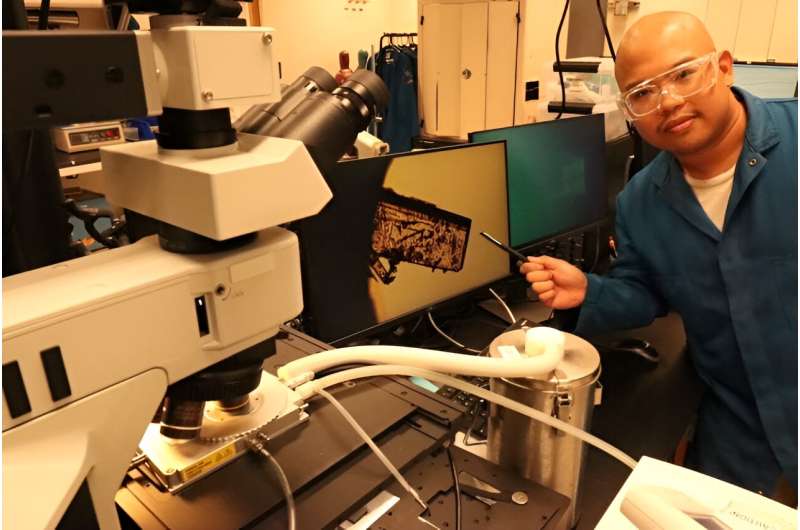
Using a microscope, UC Irvine postdoctoral fellow Dmitri Cordova examines a sample of the crystal that Professor Maxx Arguilla’s lab used to discover the new nanothermometers. Image credit: Lucas Van Wyk Joel
Scientists at the University of California, Irvine, have discovered a one-dimensional nanomaterial that changes color with temperature changes. The team’s results appear in Advanced materials.
“We found that we can make really small and sensitive thermometers,” said Maxx Arguilla, a chemistry professor at UC Irvine whose research group led the study. “It’s one of the most application-oriented and transferable pieces of work from our lab.”
Arguilla compared the thermometers to “nanoscale mood rings,” referring to jewelry that changes color based on the wearer’s body temperature. But rather than simply taking a qualitative temperature reading, the color changes in these materials “can be calibrated and used to optically take nanoscale temperature readings,” Arguilla said.
“The need to measure temperature is important because many biological and industrial processes depend on tracking tiny temperature changes,” he added. “Perhaps we now have thermometers that we could put inside cells.”
According to Dmitri Cordova, a postdoctoral researcher in Arguilla’s group, the optical thermometers may also be able to measure temperatures and evaluate the efficiency of micro- and nanoelectronics, including circuits and data storage devices. Industry already has optical thermometers that it uses in the manufacture of computer components, but the team’s new material is “at least an order of magnitude more sensitive,” Cordova said.
The breakthrough came when Cordova and his colleagues grew crystals in their lab that resembled spiral “slinkies” on a nanometer scale. They first grew the crystals to subject them to heat stress to see at what temperature the crystals decayed.
Cordova and student Leo Cheng noticed that the color of the crystals systematically shifted from yellow to orange depending on the temperature.
The team then took precise measurements of the temperature range the colors corresponded to and found that light yellow hues corresponded to temperatures around -190 degrees Celsius, while red-orange hues corresponded to temperatures around 200 degrees Celsius.
“We have made great efforts to ensure that the measurements are precise,” said Arguilla.
To take nanosamples of the material, the lab stuck a piece of tape onto large crystals, peeled it off, and transferred the nanosamples stuck to the tape onto transparent substrates.
“We can peel off these structures and use them as nanothermometers that can be transferred, reconfigured and coupled with other materials or surfaces,” Arguilla said.
Arguilla explained that the discovery is the first step towards exploring new classes of materials for temperature measurement at the nanometer scale.
Next, his lab plans to test other materials at the nanoscale to see if thermometers can be developed that can measure a wider range of temperatures.
“We are now trying to circumvent the rules of material design to make even more sensitive materials,” said Arguilla. “We are trying to open the toolbox for optical thermometry from the mass scale down to the nanoscale.”
Co-authors include Yinong Zhou, Griffin M. Milligan, Leo Cheng, Tyler Kerr, Joseph Ziller, and Ruqian Wu.
Further information:
Dmitri Leo Mesoza Cordova et al, Sensitive thermochromic behavior of InSeI, a highly anisotropic and tubular 1D van der Waals crystal, Advanced materials (2024). DOI: 10.1002/adma.202470162
Provided by the University of California, Irvine
Quote: Scientists develop material that can withstand the temperature of nanoscale objects (August 14, 2024), accessed August 14, 2024 from https://phys.org/news/2024-08-scientists-material-temperature-nanoscale.html
This document is subject to copyright. Except for the purposes of private study or research, no part of it may be reproduced without written permission. The contents are for information purposes only.



